
12 Days Yunnan Trekking Tour from Lugu Lake to Baoshan Stone Town and Tiger Leaping Gorge
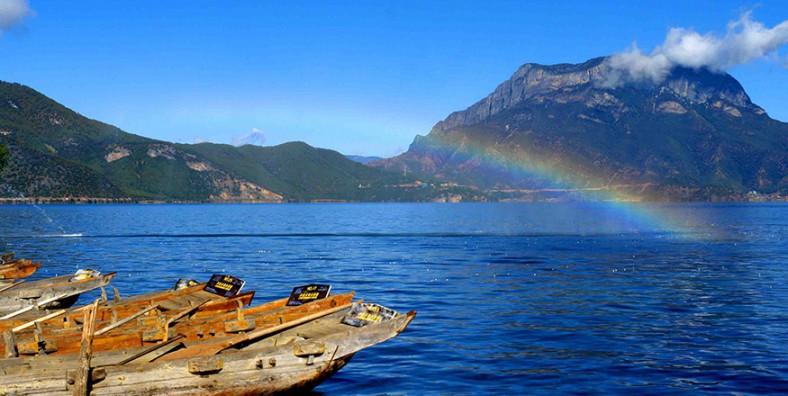
Tour Overview
This 12 days trekking tour will take you to appreciate the impressive scenery along the road, the most romantic part of this trekking tour is from Baoshan stone town...
Code of Tour: CDT0000000876
Length of Travel: 12 Day
Destinations of Tour: Lijiang-Lugu Lake-Yongning-Zhuangzi-Fengke-Baoshan-Daju-Tiger Leaping Gorge-Shangrila
Departure City: Lijiang
Price of Tour: Request
Type of Tour: Private
Features of Tour: Hiking Minority
This 12 days trekking tour will take you to appreciate the impressive scenery along the road, the most romantic part of this trekking tour is from Baoshan stone town to Lugu lake, take twice ferry across the lake with our donkeys, and pilgram to Lugu lake.
Highlights:
- Visit the highlights of Yunnan.
- Enjoy the splendid scenery along the road.
- Explore the elegance and charms of Yunnan.
Brief Itinerary
- Day 1: Lijiang Arrival
- Day 2: Lijiang
- Day 3: Lijiang-Lugu Lake
- Day 4: Lugu Lake
- Day 5: Luguhu Lake-Yongning-Zhuangzi Pass-Zhuangzi
- Day 6: Zhuangzi-Labo-Fengke
- Day 7: Fengke Town-Liuqing Village
- Day 8: Liuqing Village-Baoshan Stone Town
- Day 9: Baoshan Stone Town-Daju-Middle Tiger Leaping Gorge
- Day 10: Middle Tiger Leaping Gorge-Halfway Guesthouse-Baishuitai-Shangrila
- Day 11: Shangri-La
- Day 12: Departure from Shangri-La
Google Map
Detailed Itinerary
Day 1 Lijiang Arrival
Sightseeing and Activities: Lijiang Old Town, Black Dragon Pool and Dongba Museum
Accommodation:
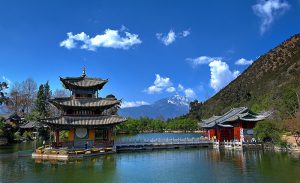
Meals:
Begin our journey in Lijiang, which is the travel highlight of Yunnan. Be met by your guide in Lijiang airport. And then transfer to the hotel.
In the afternoon, walk from the water wheels of Lijiang Old Town to visit Black Dragon Pool and learn the Naxi ethnic culture in Dongba Culture Museum in Black Dragon Park.
The rest of time will be free in Lijiang Old Town.
Day 2 Lijiang
Sightseeing and Activities: Shuhe Old Town, Mu Emperor’s Palace, Lion Hill£¬Baisha Village and Mural.
Accommodation:
Meals: Breakfast, Lunch
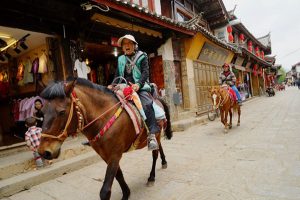
Head for Shuhe Old Town, which is the relic of the Tea-Horse Trading Caravan from back of Mekong River to India via Tibet. Planning to walk from LongQuan (Drangon Spring) in Shuhe Old Town to Baisha Village, you will visit the the Naxi family and Baisha Muralin Baisha village. Lunch at “Just Here Restaurant” in Baisha Street
After lunch drive back to Lijiang and visit the Wangu Pagoda on the top of the Lion Hill, here you will have a wonderful panoramic view of Lijiang Old Town. Then walk down from the Lion Hill to Mu Emperor’s Palace which is the local chieftain’s former residence.
–Have an option to attend the Naxi Orchestral and Show in Naxi Concert in the Lijiang Old Town at night.
Day 3 Lijiang-Lugu Lake
Sightseeing and Activities: the upper Yangtze Grand Canon,Yi and Pumi Ethnic Villages, Lugu Lake
Accommodation:
Meals: Breakfast, Lunch
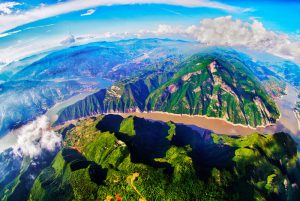
In the morning, dive 6 hours on the spectacle mountain road to visit the mysterious Lugu Lake. On the way, enjoy the beautiful view among the huge mountains and rivers. Start our walking from Jin’anqiao Bridge to Shudi along the road. After 1 hour’s walking, continue the driving and we can stop in many Yi villages.
Late afternoon, visit Mosuo Ethnic Museum and Luoshui Village around Luguhu Lake.
–Matriarchal Society of Mosuo Ethnic People
As in many other matriarchal societies this one is both matrilineal and matrilocal. However, beyond the lack of property ownership and policy making decisions, the men are also placed in a subservient role in sexual matters as well. A woman of the Mosuo selects a partner during a ritualistic dance. Such unions last at the woman’s discretion, lasting as briefly as one night to becoming a lifelong partnership. With such a highly fluid relationship pattern in effect many men are in a marriage system called tisese. They are Tibetan Buddhist by religion.
Day 4 Lugu Lake
Sightseeing and Activities: Heiwawu Island and Liwubi Island of Luguhu Lake Mosuo Ethnic Home-made
Accommodation:
Meals: Breakfast, Lunch
In the morning, take the canoes to visit Liwubi Island and Heiwawu Island in Lugu Lake.
Visit a Mosuo ethnic family in the afternoon and enjoy the Mosuo ethnic life in the village. Afternoon, walk along the Luguhu Lake by yourself. Enjoy the sunset wonder of Luguhu Lake in Luoshui Village. Take a special Barbecue dinner with beef, mutton, pork, fish, frog, and some vegetables in the Barbecue City.
In the evening, take part in Mosuo Bonfire Party with ethnic dance and singing performance, dance and sing with Mosuo boys and girls around a big bonfire in the outdoors theatre.
–The area where the Mosuo lived was named “Yongning”, which means “a place of eternal peace and stability”. The army of the Yuan Dynasty took camp for a time at the valley in Yongning, which is called “Riyuehe”, which means “the place where sun and moon are in harmony.” Here the army was able to recover and the Mosuo were not bothered.
The Mosuo live at the shores of lake Lugu, situated on the South-West of China, it has common borders with the provinces of Sichuan and Yunnan. The population of the ethnic group of the Mosuo is 30.000. They have their own distinct language, but no script. They have their own native Daba religion and some are adherence to Tibetan Lamaism. The highest elevation of the area they inhabit is 3.200 meters and the lowest 800 meters. They have inhabited in this area more than 1600 years according to the documents of the Han Dynasty.
Due to the very mountainous terrain where they inhabit, the Mosuo has not much contact with the “outside world” except through and ancient “Tea-Horse-Road”. Many of their daily needs are met through trading with a caravan. There is also a Southern route which is more further and it takes the caravan one whole year to make the journey to Tibet and back. The Mosuo community has been isolated for a very long time and has lived a self reliant and self-managed lifestyle. This provides very clear evidence of the validity of its culture and traditions.
Day 5 Luguhu Lake-Yongning-Zhuangzi Pass-Zhuangzi
Sightseeing and Activities: Yongning Town, Zhamei Monastery, Zhuangzi Pass(3500M)
Accommodation:
Meals: Breakfast, Lunch
Drive along the Luguhu Lake and arrive in Yongning Town, visit Mosuo ethnic market and Zhamei Monastery.
Start the trekking to Zhuangzi Village with original forest on the way. Firstly, trek to the top of Zhuangzi Pass with 3500 meters above the sea level which is the highest point in this trekking trip.
Overnight at Xiong Family Hostel(Clean room with public bathroom and hot water for shower)
–Yongning Town is an important town of the Ancient Tea-Horse Trade Caravan from Yunnan to Tibet, which is located between Yunnan and Sichuan, Yongning keeps the original ethnic life which is still not damaged by tourists. We will arrange to visit a Mosuo family and have lunch in Mosuo family, enjoy the Mosuo real life in a village.
Day 6 Zhuangzi-Labo-Fengke
Sightseeing and Activities: Zhuangzi Village, Labo Village, Fengke Town, Pumi ethnic people
Accommodation:
Meals: Breakfast, Lunch
This stage is a long and weary climb, reserved for keen hikers who are still in good physical quality after the first stage.
Ferry: The elevation first drops to 1400m when you reach the ferry.
Labo is the first village on the east shore, you can climb through fields, streams, villages. It is difficult to find high trees giving a shade against the burning sun, and sometimes you may walk on a tractor road. After 7 hours, you can reach Fengke Town.
Fengke: A further descent to Fengke is a long but gentle hike, with enjoyable views of Jinsha River. Several villages can be found along the path. Local people are friendly and children would say hello to you. Many travelers would finish their trek at Fengke as landscapes of the first stage are the most breathtaking. They can take a morning bus going back to Lijiang.
Day 7 Fengke Town-Liuqing Village
Sightseeing and Activities: Jinsha River, Liuqing Village
Accommodation:
Meals: Breakfast, Lunch
Trek from Fengke Town to Liuqing Village.
Liuqin Village: Descending to the next Village Liuqin from the top of Prince Pass takes 30 minutes.
Day 8 Liuqing Village-Baoshan Stone Town
Sightseeing and Activities: Jinsha River, Taizi Mountain Pass, Baoshan Stone Town
Accommodation:
Meals: Breakfast, Lunch
Quit Liuqing Village, head south. Jinsha River (Yangzi River) flows southward on your left.
Encounter a tough ascent to the Prince Pass, steeply-incised by Jinsha Jiang. Even horses are not able to climb up here. You will have to cross two tunnels without any illumination. Torches are essential here. The first tunnel is actual the highest point of Prince Pass.
Day 9 Baoshan Stone Town-Daju-Middle Tiger Leaping Gorge
Sightseeing and Activities: Jade Dragon Snow Mountain, Daju Town, Tiger Leaping Gorge
Accommodation:
Meals: Breakfast, Lunch

Visit Baoshan Stone Village in the morning, and drive to Daju Town where is the end of the Tiger Leaping Gorge. Enjoy the wonderful view of Jade Dragon Snow Mountain from a far.
After lunch in Daju Town, walk down to Jinsha River, take the boat to the other side of Yangtze River from the Daju New Ferry. Hike along the road from the Lower Tiger Leaping Gorge to the Middle Part and visit the Walnut Grove Garden Village on the way.
If time permits, you will have an option to trek down to the Middle Rapids of Jinsha River, climb the Sky Ladder (Tianti) back to Tina’s.
You also can have the other option to trek from the Walnut Grove Garden to the Middle Rapids, and hike up to Tina’s.
— Baoshan Stone Town is not a town made of stone as it is named, but a big village built on a huge stone. The mighty nature mother brought along a heavy stone, and the diligent Naxi People turned it into a wonderland under heaven.
Baoshan Stone Town sits there, appearing uniquely simple and unsophisticated, and exhibiting the charm of local culture at the same time.
Day 10 Middle Tiger Leaping Gorge-Halfway Guesthouse-Baishuitai-Shangrila
Sightseeing and Activities: the middle Tiger Leaping Gorge, Baishuitai Terraces, Haba Snow Mountain
Accommodation:
Meals: Breakfast, Lunch

Trek from Tina’s Hostel up to Halfway Guesthouse, visit the Bamboo Forest, the Flying Cliff, Guanyin Temple and Waterfalls on the trekking.
Have a short rest in Halfway Guesthouse in Benziwan Village and enjoy the view of Jade Dragon Snow Mountain from the hostel. Continue the hiking down to the road along the Tiger Leaping Gorge, and drive back to Tina’s Hostel.
After lunch, drive to Shangri-la. On the way, visit Haba Village and Haba Snow Mountain and Baishuitai Terraces.
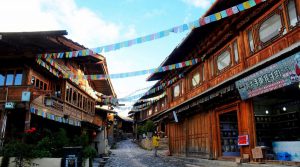
In Shangri-la, walk around Dukezong Tibetan Ancient Town which was an important town of the Tea-horse Trade Road from Yunnan to Tibet and India for the tea trading. Climb up to the top of Tortoise Hill, you will see the largest Prayer Wheel in the world, have a panoramic view of Jiantang Town and Dukezong Ancient Town as well as some white pagodas, tibetan colorful prayer flags and monasteries.
Around 7:00 at night, some Tibetan people and tourists will dance around Sifang Square in Dukezong Ancient Town,you will be warm welcomed by local people.
–Baishui Terrace or White Water Terrace is situated in Baidi village at the foot of the Haba Snow Mountain. Baishuitai in Naxi means ‘growing flower’. Not only a place of beautiful scenery, it is also one of the birthplaces of Dongba Naxi culture, widely known around the world. Each year, on the eighth day of the second lunar month, the Naxi people will gather here to celebrate their traditional festival by singing and dancing all day and night.
Day 11 Shangri-La
Sightseeing and Activities: Sogzanlin Monastery, Bita Lake & Shudu Lake, the largest prayer wheel and the Guishan Park
Accommodation:
Meals: Breakfast, Lunch

In the morning, visit the Ganden Sumtseling Monastery, the largest Tibetan monastery in Yunnan. Songzanlin Monastery has another alias – ‘the little Potala Palace ‘, so named because the whole monastery is in the traditional style with mysterious atmosphere. Walk around Songzanlin Monastery.
Then move on to the Pudacuo National Park which is located in one of the most biologically-diverse regions of the world. While the region comprises only 0.7 percent of China’s land area, it contains more than 20 percent of the country’s plant species, about one-third of its mammal and bird species and almost 100 endangered species.
Finally, visit a Tibetan’s family to experience the local life in the bonfire party with Tibetan dance and music, try Tibetan home-made yak and cheese.
Day 12 Shangri-La Departure
Sightseeing and Activities: Departure from Shangri La
Accommodation:
Meals: Breakfast, Lunch
Departure from Shangri La. Service ends.
Service Excluded:
- Admission fees for all of the sightseeing spots listed in the itinerary;
- Meals as listed in the itinerary;
- Hotels as listed in the itinerary;
- Private English-speaking tour guide;
- Private vehicle for transfers & sightseeing with skilled driver;
- Service charge & government taxes;
- Luggage transfers between airports and hotels;
- Domestic train tickets of soft sleeper.
Service Excluded:
- Any arrival and departure international airfares or train tickets;
- Chinese visa fees;
- Excess baggage charged by Airlines;
- Single room supplement;
- Tips to guides and drivers;
- Personal expenses and gratuities to service staff;
- Personal travel accident insurance;
- All optional programs.















